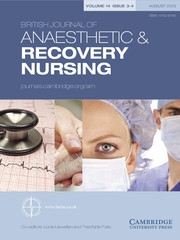No CrossRef data available.
Article contents
Care of the High Dependency Patient
Published online by Cambridge University Press: 25 February 2009
Abstract
Recent government changes to Critical Care in the Health Service have resulted in an increase in the numbers of critical care patients being nursed in Post Anaesthetic Care Units (PACU). Many recovery nurses have had to increase their knowledge and skills accordingly. This article will analyse the high dependency nursing care given to a patient in the PACU necessitated by the haemodynamic compromise of the patient's cardiovascular system following surgery. The need for admission to a high dependency bed will be discussed along with the assessment of shock, tissue perfusion, fluid replacement, and any pharmacological intervention. Psychological, social and ethical issues relating to the patient and family will also be identified. Concentrating on the first 24 hours post-operatively, a careful discussion and analysis of the clinical management given will be made, with reference to the clinical and physiological measurements. After an evaluation and reflection of the medical and nursing care given to the patient, this article will conclude with a brief reiteration of the key issues.
- Type
- Research Article
- Information
- Copyright
- Copyright © British Association of Anaesthetic and Recovery Nursing 2002


